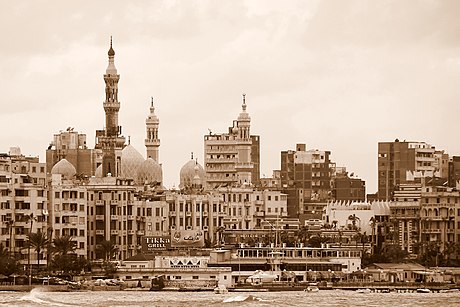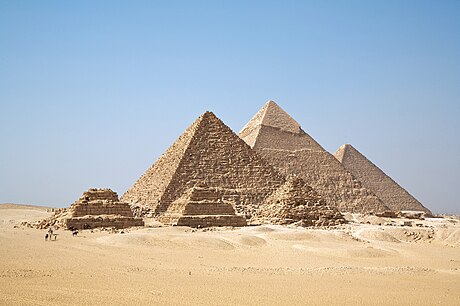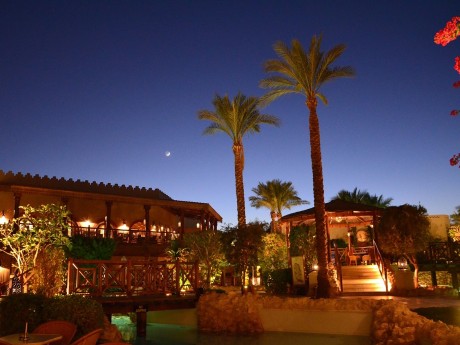Egypt: Alexandria & Cairo
Embark on an awe-inspiring expedition to Egypt, a land brimming with unparalleled wonders and enchantment! Picture yourself wandering through the historical marvels of Alexandria, basking in the echoes of ancient knowledge at the renowned Bibliotheca Alexandrina, and walking through the Stanley Bridge and Citadel of Qaitbay.
Read more
Embark on an awe-inspiring expedition to Egypt, a land brimming with unparalleled wonders and enchantment! Picture yourself wandering through the historical marvels of Alexandria, basking in the echoes of ancient knowledge at the renowned Bibliotheca Alexandrina, and walking through the Stanley Bridge and Citadel of Qaitbay. In Cairo, prepare to be utterly captivated as you stand before the majestic pyramids and the enigmatic Sphinx, two of the seven wonders of the world which are a testament to humanity's architectural brilliance and ancient mysteries. In addition, take part in Egyptian culture as you walk through bazaars and try some traditional food. Waterviews strives to offer accommodation options within walking distance of water and/or in an area of touristic interest. Our prices include taxes (but excludes local tourist taxes). Customize your trip to your personal preferences with optional activities (hit the “Add Activities’’) or change hotels, etc. Contact us for customization at no extra cost at: Service@waterviewstravel.com
Destinations
- Alexandria
- Cairo
Itinerary
Alexandria

Alexandria (pronounced al-ig-ZAN-dree-uh ; Arabic: الإسكندرية / اسكندرية al-Iskandariyya / Eskendereyya ) is Egypt's second largest city (3.5 million people), its largest seaport and the country's window onto the Mediterranean Sea.
Read more
Alexandria (pronounced al-ig-ZAN-dree-uh ; Arabic: الإسكندرية / اسكندرية al-Iskandariyya / Eskendereyya ) is Egypt's second largest city (3.5 million people), its largest seaport and the country's window onto the Mediterranean Sea.
Additional Information
Alexandria is a faded shade of its former glorious cosmopolitan self, but still worth a visit for its many cultural attractions and still-palpable glimpses of its past.
History
Few cities of the world have a history as rich as that of Alexandria; few cities have witnessed so many historic events and legends. Founded by Alexander the Great (Iskander al-Akbar) in 331 BC, Alexandria became the capital of Greco-Roman Egypt; its status as a beacon of culture is symbolized by Pharos, the legendary lighthouse.
There had long been a fishing village here, called Rhakotis, but Alexander had greater plans for it. Its strategic value was obvious: it had a great natural harbour, a backing lagoon to prevent land attack, a fertile hinterland, and potential control of trade routes up the Nile and overland to the Red Sea and Arabia. But the approach to the harbour was tricky: the coastline and off-shore islands were low and without landmarks, so sailors could easily take the wrong channel and get wrecked on the shoals. To guide them in, Alexander's successors Ptolemy I & II built a lighthouse on the nearby island of Pharos. It stood just over 100 m tall, so only the Great Pyramids were taller. A bronze mirror atop it reflected sunlight by day, and by night the flames of oil-soaked sheep fleeces. It was one of the Seven Wonders of the ancient world, and the name of the island "Pharos" came to apply to all subsequent lighthouses, and spawned modern words such as "phares" in French.
A jetty over 1 km long was built to connect Pharos to the mainland, dividing the bay into an eastern and western harbour. Silt and landfill built up along the jetty so it broadened into a peninsula, the present-day district of Anfushi. The lighthouse was badly damaged by earthquakes in 956, 1303 and 1323, then fell into disuse and disrepair. In 1480 Sultan Qaitbey used the ruined stone to build his fortress here. The rest of it was eaten by coastal erosion, and came to lie on the sea-bed. But a combination of ancient descriptions, modern marine archaeology and satellite imaging give us a detailed picture of it.
Alexandria under Ptolemy I & II prospered not just through trading, but as a knowledge economy. They set out to acquire and understand every manuscript they could. Arriving ships were searched, and any manuscripts seized and copied onto papyrus. In the great Library of Alexandria texts were translated, catalogued and studied. Scholars, philosophers and scientists flocked to work on these texts, and to create new material. Just one example of their creative output was the Septuagint, the first Greek translation of Hebrew holy texts that became the Christian Bible Old Testament.
Trade and knowledge made Alexandria cosmopolitan, with the largest Jewish populations and Hellenistic cultures anywhere. It retained its importance, and was capital of Egypt, while power was shifting elsewhere: the rise and decline of Rome, the rise of Byzantium, and growth of Persia. But the city suffered natural disasters (eg the tsunami of 365 CE) and a series of wars (particularly against Rome), and the library was destroyed. When the Arabs conquered Egypt in 641 CE they founded a new capital to the south in Fustat, now Cairo. Politically, economically and intellectually, Alexandria was no longer the place to be.
Alexandria survived as a trading port; Marco Polo described it around 1300 as one of the world's two busiest ports, along with Quanzhou. However, its strategic location meant that every army on its way to Egypt passed through: Napoleon's troops stormed the city in 1798, but the British conquered it in the Siege of Alexandria in 1801. The Egyptians under Mohammed Ali took control of the city and rebuilt it, but the Orabi Rebellion in 1881 and massacres of Europeans in the city led the British to strike back and hammer the rebels with the three-day Bombardment of Alexandria, reducing much of the city center to rubble.
Once again, Alexandria rose from the ashes. Its cosmopolitan and decadent lifestyle before and during World War II gave birth to its greatest poet, Constantine P. Cavafy, and was chronicled in Laurence Durrell's Alexandria Quartet and a series of works by E.M. Forster including Alexandria: A History and Guide (1922), described by some as the best travel guide ever written.
Yet this world, too, took a shattering blow in the 1950s when Egypt's new fiercely nationalist leader Gamal Abdel Nasser nationalized vast swathes of the economy and forbade foreigners from owning or running companies, effectively forcing tens of thousands of foreigners out of the country, including virtually all of Alexandria's once 150,000-strong Greek community. Alexandria thus ceased to be a cosmopolitan city.
Today's Alexandria is a dusty seaside Egyptian town with miles of tatty low-rise and 'burbs holding its population of 5 million, yet its status as Egypt's leading port keeps business humming, and tourists still flock to the beaches in the summertime. And while much of the city is badly in need of major repair, its history is still evident: the French-style parks and the occasional French street sign survive as a legacy of Napoleon, and the few remaining Greek restaurants and cafés still do a good trade.
Climate
Alexandria has a hot desert climate (BWh), but highly influenced by sea breeze, with sunny hot humid summers and mild moderately wet winters. The daytime can be humid in summer, with summer temperatures averaging 31 °C (88 °F), but evenings are usually cooler and breezy, especially by the Corniche. Winters can get cold, with daytime highs down sometimes to 12 °C (53 °F), with occasional rain and sometimes hail. Humidity is high throughout the year. The best time to visit Alexandria is in spring (March–June) and autumn (September–November), since it's at its busiest in summer, when Egyptians flock down to escape the searing heat of Cairo.
{|class# "wikitable" style"font-size:smaller; width:70%" |+Alexandria mean sea temperature |- !Jan !Feb !Mar !Apr !May !Jun !Jul !Aug !Sep !Oct !Nov !Dec |- |18°C (64°F) |17°C (63°F) |17°C (63°F) |18°C (64°F) |20°C (68°F) |23°C (73°F) |25°C (77°F) |26°C (79°F) |26°C (79°F) |25°C (77°F) |22°C (72°F) |20°C (68°F) |}
Orientation
Alexandria is a long thin city, pinched between the swampy delta and the sea. Its east-west artery, the Corniche, rolls on for about 30 km. However the advantage to the visitor is that all transport is funnelled along this corridor, so you shouldn't wait more than a minute for a taxi, buses or microbus going your way. The tram line runs parallel a block or two further inland.
At the western tip lies the Citadel of Qaitbey, built near (and from) the ruined ancient lighthouse or Pharos. The Corniche then sweeps around the eastern harbour, with Anfushi the tongue of land behind it, to the central hotel area around Saad Zaghloul; then passes the east end of the harbour at the jetty opposite the new library. Almost all the sights, and the bulk of the accommodation and restaurants, are along this congested 5-6 km strip or nearby. But on and on eastwards rolls the Corniche through rundown beachfront districts of Rushdy, San Stefano and Mandarah. The blingy hotels of Montazah are a bright spot then the tat, burbs and ribbon-development resume, out to Aboukir.
Tourist offices
© Sourced from Wikivoyage
Cairo

Cairo (pronounced KY-roh<span style# "margin-left:1px">; Arabic: <span lang"ar">القاهرة al-Qāhirah) is the capital of Egypt and, with a total population of Greater Cairo metropolitan area in excess of 16 million people, one of the largest cities in both Africa and the Middle East (the regions which it conveniently straddles). It is also the 19th largest city in the world, and among the world's most densely populated cities.
On the Nile river, Cairo is famous for its own history, preserved in the fabulous medieval Islamic city and Coptic sites in Old Cairo — with historic Cairo inscribed on the UNESCO World Heritage list. The Egyptian Museum in the city centre is a must see, with its countless Ancient Egyptian artefacts, as is shopping at the Khan al-Khalili bazaar. No trip to Cairo would be complete without a visit to the Giza Pyramids and to the nearby Saqqara Pyramid Complex, where visitors will see Egypt's first step pyramid built by the architect Imhotep for the third dynasty pharaoh Djoser.
Though firmly attached to the past, Cairo is also home to a vibrant modern society. The Midan Tahrir area situated in downtown Cairo, built in the 19th century under the rule of Khedive Ismail, has strived to be a "Paris on the Nile". There also are a number of more modern suburbs including Ma'adi and Heliopolis, while Zamalek is a quiet area on Gezira Island, with upmarket shopping. Cairo is best in the fall or spring, when the weather isn't so hot. A felucca ride on the Nile is a good way to escape from the busy city, as is a visit to Al-Azhar Park.
Since the revolution in 2011 and the ongoing counter-revolution, tourists have fled Cairo to a large extent. This has created an opportunity for unique experiences of Cairo's and Egypt's cultural treasures without the crowds. Finding yourself alone inside a pyramid is now a real possibility. Prices are also lower.
Read more
Cairo (pronounced KY-roh<span style# "margin-left:1px">; Arabic: <span lang"ar">القاهرة al-Qāhirah) is the capital of Egypt and, with a total population of Greater Cairo metropolitan area in excess of 16 million people, one of the largest cities in both Africa and the Middle East (the regions which it conveniently straddles). It is also the 19th largest city in the world, and among the world's most densely populated cities.
On the Nile river, Cairo is famous for its own history, preserved in the fabulous medieval Islamic city and Coptic sites in Old Cairo — with historic Cairo inscribed on the UNESCO World Heritage list. The Egyptian Museum in the city centre is a must see, with its countless Ancient Egyptian artefacts, as is shopping at the Khan al-Khalili bazaar. No trip to Cairo would be complete without a visit to the Giza Pyramids and to the nearby Saqqara Pyramid Complex, where visitors will see Egypt's first step pyramid built by the architect Imhotep for the third dynasty pharaoh Djoser.
Though firmly attached to the past, Cairo is also home to a vibrant modern society. The Midan Tahrir area situated in downtown Cairo, built in the 19th century under the rule of Khedive Ismail, has strived to be a "Paris on the Nile". There also are a number of more modern suburbs including Ma'adi and Heliopolis, while Zamalek is a quiet area on Gezira Island, with upmarket shopping. Cairo is best in the fall or spring, when the weather isn't so hot. A felucca ride on the Nile is a good way to escape from the busy city, as is a visit to Al-Azhar Park.
Since the revolution in 2011 and the ongoing counter-revolution, tourists have fled Cairo to a large extent. This has created an opportunity for unique experiences of Cairo's and Egypt's cultural treasures without the crowds. Finding yourself alone inside a pyramid is now a real possibility. Prices are also lower.
Additional Information
Cairo is on the Nile, and has ancient origins in the vicinity of the Pharaonic city of Memphis. The city started to take its present form in 641 CE, when the Arab general Amr Ibn Al-Ase conquered Egypt for Islam and founded a new capital called Misr Al-Fustat, "the City of the Tents". (The legend is that Al-Ase, on the day he was leaving to conquer Alexandria, found two doves nesting in his tent. Not wanting to disturb them, he left the tent. Upon returning victorious, he called his soldiers to pitch their tents around his, and this became the site of the new city in what is now Old Cairo.) The name may have been a pun - Misr/Masr is the Arabic word for city, but it is also the Arabic name of the entire country of Egypt. The Tunisian Fatimid dynasty captured the city in 969 CE and founded a new city, Al-Qahira ("The Victorious") just north of Al-Fustat. Al-Qahira gave the city its English name, Cairo, but the locals still call it MàSr (مصر), which is also the Arabic name of the entire country of Egypt (similar to Mexico City in Mexico).
Climate
The best time to visit Cairo is during the winter from November to March, when daytime highs mostly stay below 26°C (79°F), with night time lows around 10°C (50°F) with occasional rain showers clearing the air, but still, you do not need an umbrella, even the rainiest months of the year rarely top 10 mm (0.4 in).
If visiting during winter, be aware that not all buildings are equipped with heaters, including some hotels and hostels. Visitors should always pack a few warm jumpers (sweaters) and a warm jacket for evening wear. In Cairo, in indoor buildings without air-conditioning, temperatures are about 15°C (59°F) in the coldest winter days and about 34°C (93°F) in the hottest summer days.
The brief spring from March to May can be pleasant as long as there are no sand storms, but summer temperatures, on the other hand, can reach a searing 38°C (100°F). In September and October, the period of late summer and early autumn, farmers burn rice husks to ash after sunset near Greater Cairo and this makes the air smokey.
Orientation
Today's Greater Cairo is a city with at least 17 million inhabitants, where skyscrapers and fast food restaurants nestle up to world heritage monuments. Cairo used to be the designated name of the city on the eastern bank of the Nile, and this is where you'll find both the modern Downtown, built under influence of French architecture, today the centre of commerce and popular life, as well as historical Islamic and Coptic sights.
Outside the core on the eastern bank, you'll find the modern, more affluent suburbs of Heliopolis and Nasr City near the airport, and Ma'adi to the south. In the middle of the Nile is the island of Gezira and Zamalek, where many embassies exist. On the western bank is lots of modern concrete and business, but also the great Giza pyramids and, further to the south, Memphis and Saqqara. The city might seem like a lot to handle, but give it a try, and you will find that it has a lot to offer for any traveller.
© Sourced from Wikivoyage





